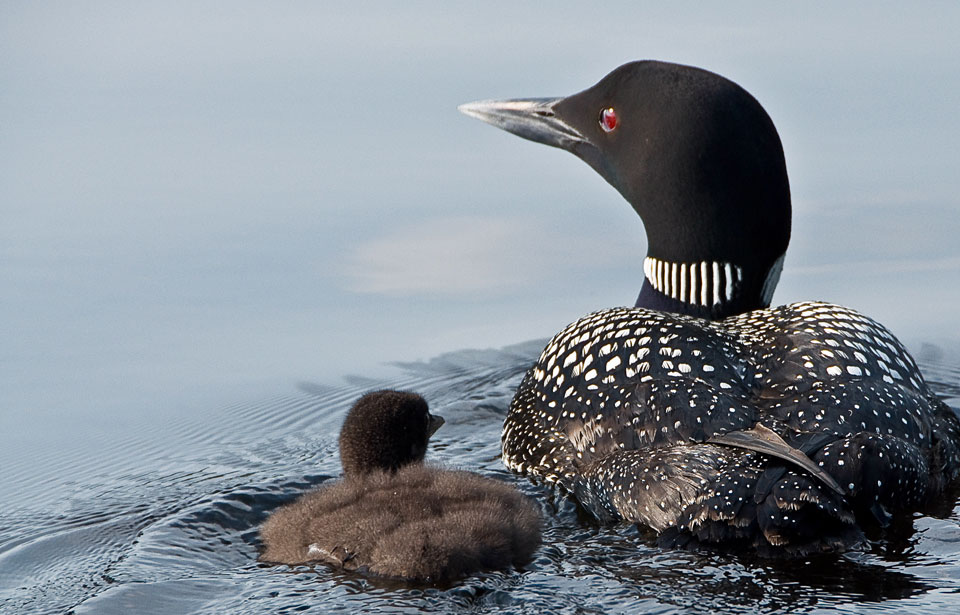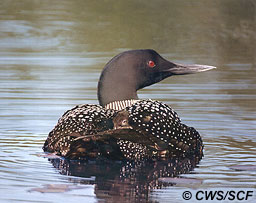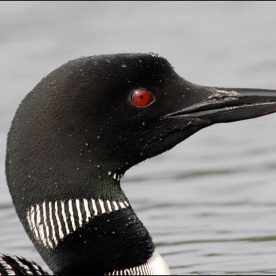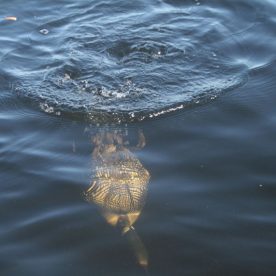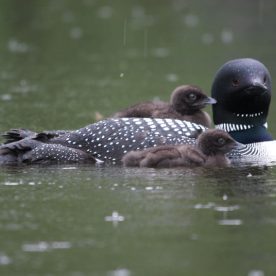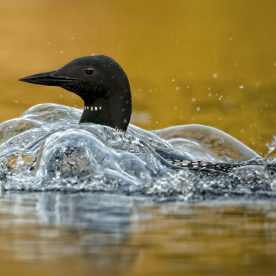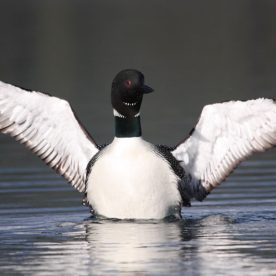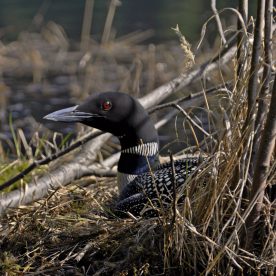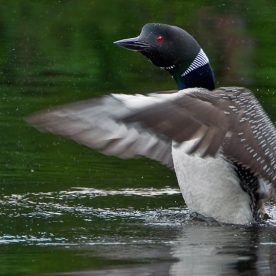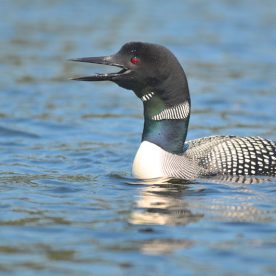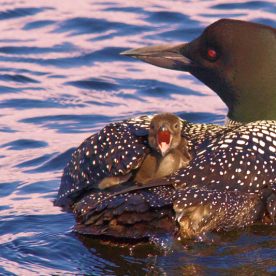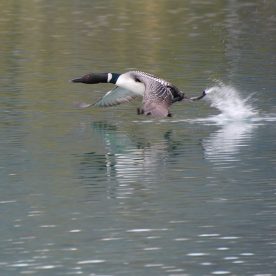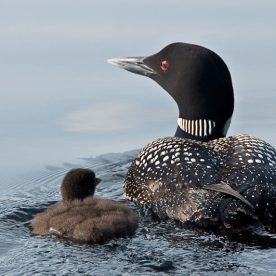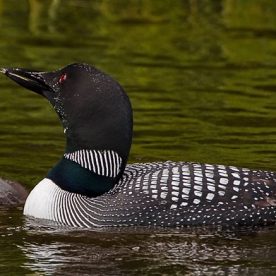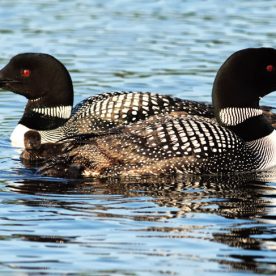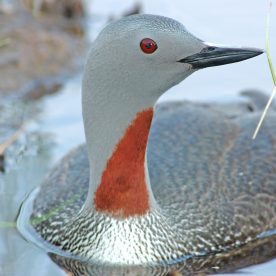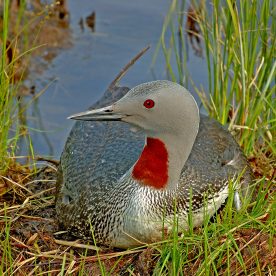Description
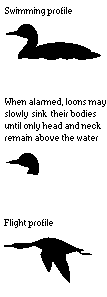 Loons are water birds like ducks, geese, and grebes, but they are classified separately by scientists. The five species are Red-throated Loon Gavia stellata, Pacific Loon Gavia pacifica, Arctic Loon Gavia arctica, Yellow-billed Loon Gavia adamsii, and Common Loon Gavia immer. The Common Loon is the species best known to most of us, as its breeding range lies across most of Canada.
Loons are water birds like ducks, geese, and grebes, but they are classified separately by scientists. The five species are Red-throated Loon Gavia stellata, Pacific Loon Gavia pacifica, Arctic Loon Gavia arctica, Yellow-billed Loon Gavia adamsii, and Common Loon Gavia immer. The Common Loon is the species best known to most of us, as its breeding range lies across most of Canada.
The Common Loon in summer is very striking with its black-and-white checkered back, glossy black head, white belly and wing lining, and characteristic white necklace around the throat. All loons have greyish feathers in the winter, and immature birds tend to resemble adult birds in winter plumage. The white feathers of the belly and wing linings are present year-round.
Loons’ habit of swimming low in the water helps to distinguish them from other waterbirds, such as ducks and geese. Loons most resemble the grebes, but can be identified by their larger size, thicker necks, and longer bills. In flight, loons can be recognized by their humpbacked profile, with head and neck held low and feet pressed back towards the body and projecting beyond the tail.
Males and females look the same, although males are generally larger. Adults are large-bodied, weighing from 2.7 to over 6.3 kg and measuring almost a metre from bill tip to outstretched feet. The bill is quite large, averaging 75 mm in length, and is black in colour throughout the year.
The skeleton and muscular system are designed for swimming and diving. Loons are streamlined. Their legs are placed far back on their body, allowing for excellent movement in water but making them ungainly on land. The head can be held directly in line with the neck during diving to reduce drag, and the legs have powerful muscles for swimming.
 |
| Red-throated Loon Photo: USFWS/Dave Menke |
The small Red-throated Loon takes its name from a triangular patch of chestnut-red on its throat. Its head and neck are soft slate-grey, and the back of its neck is streaked with fine white lines. Wings and back are brownish grey with little marking. Its underparts are white.
 |
| Pacific Loon Photo: USFWS |
The Pacific Loon is the other small loon that breeds in northern Canada. The crown and hind neck of this bird are pearl-grey and the underneck and throat are black. A series of white lines streaks the sides of the upper breast, and the underparts are silvery white. White squares arranged in lines form four obvious patterns on the back of the wings and upper back.
 |
| Arctic Loon Photo: USFWS |
The Arctic Loon is only an occasional nonbreeding visitor to British Columbia. In the past, the Arctic Loon and Pacific Loon were grouped together under the name “Arctic Loon.”
The Yellow-billed Loon closely resembles the Common Loon, although it is usually larger. It may be distinguished only by its yellow-white bill, the lower half of which angles up.
Signs and sounds
Perhaps one of the most fascinating things about Common Loons is their haunting and variable voice. Loons are most vocal from mid-May to mid-June. They have four distinct calls, which they use in varying combinations to communicate with their families and other loons. These are the tremolo, wail, yodel, and hoot. The tremolo sounds like a crazy laugh and is used for a variety of purposes, such as to signal alarm or worry and to denote annoyance or greeting.
The wail is one of the loveliest of loon calls. It is used frequently during social interactions between loons and may be used to regain contact with a mate during night chorusing and in answering other loon tremolos.
The yodel is given only by the male. It is a long, rising call with repetitive notes in the middle and can last up to six seconds. It is used by the male to defend territory and can be stimulated by another male entering a loon’s territory. Studies of recordings have shown that the yodel is different for each bird and can be used to identify individual loons.
The hoot is a one-note call that sounds more like hoo. It is mainly used by family members to locate each other and check on their well-being.
Habitat and Habits
Loons have long been considered by many North Americans as beautiful and special, symbolizing wilderness and solitude. Many cottage-goers, campers, and vacationers would feel their trip was incomplete without seeing a loon or listening to its haunting call.
Hunting, feeding, resting, preening, and caring for young are the loon’s main activities. The bird spends long rest periods motionless on the water. It may rouse itself to stretch a leg or wing at intervals, occasionally comically waggling a foot. When swimming on top of the water it will sit erect with neck slightly curved. The loon will peer underwater, moving its head from side to side to locate prey. It then aims and dives quickly. It will stay underwater for almost a minute and can dive to depths of 80 m. During the dive, feathers are compressed and air is forced from between the feathers and from the air sacs in the body. Loss of air from the air sacs also allows the loon to quietly sink below the water surface to avoid danger.
Adult loons may fly to different lakes to feed. The adaptations that make loons such efficient divers also make them heavy and slow to take wing.
Common Loons spend most of the time on water and have to pull themselves onto land to nest. They generally move one foot at a time to walk, shuffling along with their breast close to the ground. The loon returns to the water by sliding in along its breast and belly. At night, loons sleep over deeper water, away from land for protection from predators.
Unique characteristics
Loon chicks can swim right away but spend some time on their parents’ backs to rest, conserve heat, and avoid predators such as large carnivorous fish, snapping turtles, gulls, eagles, and crows.
Many bones of the loon’s body are solid, rather than hollow like other birds’, which aids in diving ability. During dives, the large webbed feet provide all of the propulsion and the wings are held tight unless they are used to help make sharp turns while chasing prey.
The adaptations that make the loon such an efficient diver also make it heavy and slow to take wing. To take off from a lake, the loon runs along the surface into the wind. The distance needed to gain flight depends on wind speed; in calm times the bird may run as far as several hundred metres before it gains enough speed to take off. Once in the air, the loon can travel swiftly. Its relatively small wingspan (130 to 140 cm) carries it at average speeds of 120 km per hour during migration. The wings beat quickly to carry the large body and have a high degree of curvature to provide lift.
Range
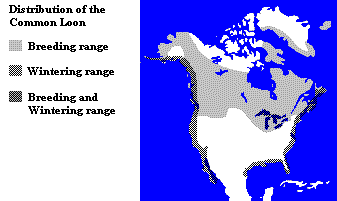
All five species of loons migrate to warmer areas around the Gulf of Mexico and on the east and west coasts of North America for the nonbreeding season, and return to northern lakes to breed when the ice melts in spring.
The Common Loon breeds in most of Canada. It spends the nonbreeding season along the Pacific and Atlantic coasts of North America, from Alaska and the island of Newfoundland in the north to Mexico in the south.
The breeding range of the Red-throated Loon includes northern Canada. It takes off from water more readily than the other loons, so is able to nest on the smaller tundra ponds. The Red-throated Loon may be seen in both eastern and western Canada during migration, but is more common in the Great Lakes region. It spends the nonbreeding season off both coasts.
The Pacific Loon also breeds in northern Canada. It congregates in large numbers off the west coast in winter. In recent years, numerous migrating Pacific Loons have been seen in autumn in west-central Alberta.
The Arctic Loon is only an occasional nonbreeding visitor to British Columbia.
The Yellow-billed Loon breeds from Great Slave Lake northward across the western Arctic. It winters on northern seas and is not likely to be seen in settled parts of Canada.
Feeding
Loons are predators; their diet in summer consists of fish, crayfish, frogs, snails, salamanders, and leeches. Adult loons prefer fish to other food, and seem to favour perch, suckers, catfish, sunfish, smelt, and minnows.
Breeding
Loons arrive in pairs on northern lakes in the spring as soon as the ice thaws. They are solitary nesters. Small lakes, generally those between 5 and 50 ha, can accommodate one pair of loons. Larger lakes may have more than one pair of breeding loons, with each pair occupying a bay or section of the lake. Until recently, loons were thought to mate for life. Banding studies have shown that loons will sometimes switch mates after a failed nesting attempt, even between nestings in the same season. Courtship and mating are a quiet time, with the pair swimming and making short dives together. Eventually the male leads the female to a suitable spot on land for mating. Nest building then begins.
Loons build their nests close to the water, with the best sites being completely surrounded by water, such as on an island, muskrat house, half-submerged log, or sedge mat—a clump of grass-like water plants. Generally the birds can slip directly from the nest to water. The same sites are often used from year to year. Loons will use whatever materials are on hand to build their nests. Researchers have found tree needles, leaves, grass, moss, and other vegetation under loon eggs. If material is not handy, loons will lay their eggs directly on the mud or rock. Sometimes clumps of mud and vegetation are collected from the lake bottom to build the nest. Both the male and female help in nest building and with incubation, or warming the eggs, which lasts until hatching, usually 26 to 31 days. If the eggs are lost, the pair may renest, often in the same general location.
Usually two eggs are laid in June, and towards the end of the month loon chicks covered in brown-black down appear on the water. Loon chicks can swim right away, but spend some time on their parents’ backs to rest, conserve heat, and avoid predators such as large carnivorous fish, snapping turtles, gulls, eagles, and crows. After their first day or two in the water, the chicks do not return to the nest.
Chicks are fed exclusively by their parents for the first few weeks of life, and up until eight weeks of age the adults are with them most of the time, providing most food. After this time the chicks begin to dive for some of their own food and by 11 or 12 weeks of age, the chicks are providing almost all of their own food and may be able to fly. Chicks are fed small food items early in their life including snails, small fish, crayfish, minnows, and some aquatic vegetation. As they grow, they require more protein, and usually are fed more fish, if available. At migration time, the young are able to look after themselves, and the adults generally leave first, with young following soon after.
Sometimes loons gather into small groups in the summer. In September, group feeding is quite common as loons gather on larger lakes while migrating. Loons are also usually found in groups on the wintering grounds.
The life expectancy of the loon may be 15 to 30 years.
Conservation
All loons are protected by federal law and may not be hunted. Although loons still nest in large numbers across Canada, recent studies have shown cause for concern about low breeding success, especially of the Common Loon. Because this loon nests in populated areas of Canada and the United States, it is susceptible to the effects of pollution, development, and disturbance. Historic data show that loons have abandoned some of their former nesting areas in the southern parts of Canada and the northern areas of the central United States. Loss of breeding habitat and disturbance are probably the main causes of this reduction in the original breeding range. Loss of habitat results from lakeshore development and spills of oil and other pollutants. Physical interference with nests or young and increased boat wake on lakes, which may swamp or destroy nests, also cause loons to abandon some nesting sites.
Recent studies have indicated that loon nesting success and survival of young may decrease with increased lake acidity, the result of acid rain. Acidity can result in decreases in fish and other foods, causing loon chicks on very acid lakes to starve. Acidification of lakes may also increase the rate of methylmercury production by microbes in lake sediments and water, resulting in higher concentrations of mercury in the food chain.
A significant proportion of loons found dead in the United States and Canada have high concentrations of mercury in their tissues. Loon die-offs in nonbreeding habitats off the Gulf Coast of Florida have been linked to poor body condition and elevated mercury concentrations. Canadian research has demonstrated that loons nesting near industrial sources of mercury pollution occupy few potential territories and lay few eggs, resulting in poor reproductive success. Increased methylmercury concentrations in fish, the loon’s main food source, is the result of environmental mercury pollution, acidification, and flooding of forested land for hydroelectric development. These activities pose a threat to the health and reproductive success of loons in many locations throughout their range.
Loons are also dying of lead poisoning after eating fish with lead sinkers, and possibly after picking up discarded sinkers from lake bottoms. The lead is partially dissolved in the loon’s gizzard, or second part of the bird’s stomach, then absorbed into the blood and body tissues. The absorbed lead causes nerve, kidney, and other tissue damage. North American studies indicate that a significant proportion of adult loon deaths on the breeding grounds is attributable to lead poisoning from ingestion of sinkers. Abandoned or unattended fishing line and hooks also cause loon injury and death.
To protect the loons on lakes we visit, boats should be kept well away from swimming birds, particularly when they are with chicks that are too young to dive or fly. Some shoreline areas should be left undisturbed to accommodate loon nests, and boaters passing these areas should travel at speeds that do not cause wash. Seaplanes should come and go as far from nesting areas as possible, taxiing to other parts of the lake. Anglers have the responsibility of using non-lead sinkers and of ensuring that no hooks or lines are left unattended or abandoned.
If you are interested in learning more about loons or becoming involved in loon conservation, contact:
Canadian Lakes Loon Survey
Bird Studies Canada
P.O. Box 160, 115 Front Street
Port Rowan, ON N0E 1M0
Ph. 1-888-448-2473 ext. 124
Fax: 1-519-586-3532
E-mail: volunteer@birdscanada.org
Resources
Online resources
Canadian Wildlife Federation, Keep Loons Afloat
All About Birds, Red-throated Loon
Audubon Field Guide, Arctic Loon
Audubon Field Guide, Yellow-billed Loon
Print resources
Bent, A.C. 1963. Life histories of North American diving birds. Dover Publications, Inc., New York.
Dennis, Roy. 1993. Loons. Voyageur Press, Stillwater, Minnesota.
Godfrey, W. 1986. The birds of Canada. Revised edition. National Museum of Natural Sciences, Ottawa.
Klein, T. 1989. Loon magic. Northwood Press, Inc., Minocqua, Wisconsin.
McIntyre, J.W. 1988. The Common Loon: Spirit of northern lakes. University of Minnesota Press, Minneapolis.
© Her Majesty the Queen in Right of Canada, represented by the Minister of the Environment, 1990, 1994. All rights reserved.
Catalogue number CW69-4/4-2003E-HTML
ISBN 0-662-34997-0
Text: Jane Ashenden
Revision: Mary Wyndham and Tony Scheuhammer, 1994
Photo: Canadian Wildlife Service



